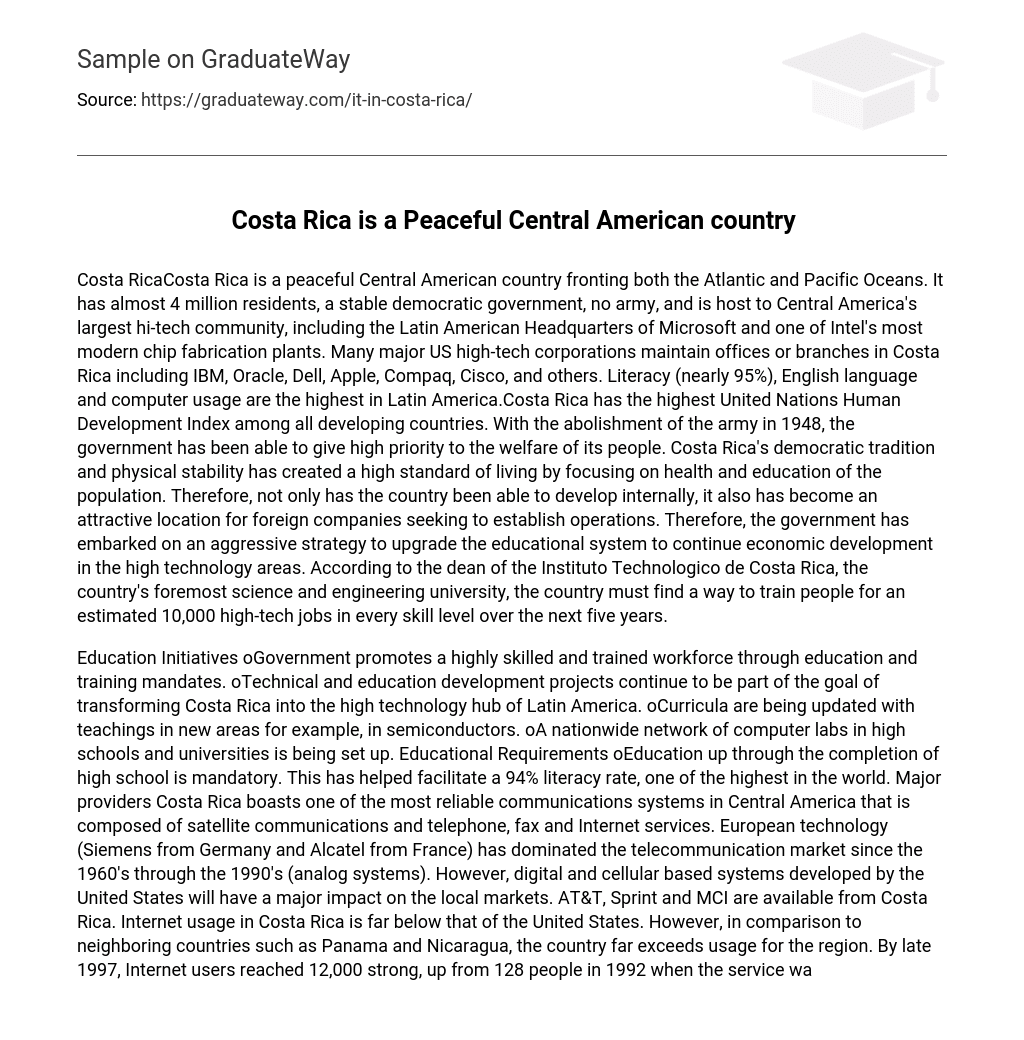Costa RicaCosta Rica is a peaceful Central American country fronting both the Atlantic and Pacific Oceans. It has almost 4 million residents, a stable democratic government, no army, and is host to Central America’s largest hi-tech community, including the Latin American Headquarters of Microsoft and one of Intel’s most modern chip fabrication plants. Many major US high-tech corporations maintain offices or branches in Costa Rica including IBM, Oracle, Dell, Apple, Compaq, Cisco, and others. Literacy (nearly 95%), English language and computer usage are the highest in Latin America.Costa Rica has the highest United Nations Human Development Index among all developing countries. With the abolishment of the army in 1948, the government has been able to give high priority to the welfare of its people. Costa Rica’s democratic tradition and physical stability has created a high standard of living by focusing on health and education of the population. Therefore, not only has the country been able to develop internally, it also has become an attractive location for foreign companies seeking to establish operations. Therefore, the government has embarked on an aggressive strategy to upgrade the educational system to continue economic development in the high technology areas. According to the dean of the Instituto Technologico de Costa Rica, the country’s foremost science and engineering university, the country must find a way to train people for an estimated 10,000 high-tech jobs in every skill level over the next five years.
Education Initiatives oGovernment promotes a highly skilled and trained workforce through education and training mandates. oTechnical and education development projects continue to be part of the goal of transforming Costa Rica into the high technology hub of Latin America. oCurricula are being updated with teachings in new areas for example, in semiconductors. oA nationwide network of computer labs in high schools and universities is being set up. Educational Requirements oEducation up through the completion of high school is mandatory. This has helped facilitate a 94% literacy rate, one of the highest in the world. Major providers Costa Rica boasts one of the most reliable communications systems in Central America that is composed of satellite communications and telephone, fax and Internet services. European technology (Siemens from Germany and Alcatel from France) has dominated the telecommunication market since the 1960’s through the 1990’s (analog systems). However, digital and cellular based systems developed by the United States will have a major impact on the local markets. AT&T, Sprint and MCI are available from Costa Rica. Internet usage in Costa Rica is far below that of the United States. However, in comparison to neighboring countries such as Panama and Nicaragua, the country far exceeds usage for the region. By late 1997, Internet users reached 12,000 strong, up from 128 people in 1992 when the service was first introduced in the country. In a study conducted by Deloitte and Touche in 1997, demand was estimated to grow to an additional 500 to 1,000 new users being added each month. According to the most recent information available one out of 101 people have Internet access, there were 1,154,000 internet users in Costa Rica in 2001. Additionally, that is 933.63 people per 10,000 Costa Ricans online. These numbers suggest that Costa Rica has the facilities and acceptance of Internet usage and this usage will most likely continue to grow at a rapid pace into the future.
Costa Rica has been assessed as the most developed and fastest growing Information Technology market in Latin America. Ronald Jimnez, CODISA, said Costa Ricans can develop software worth US$2 million in the United States, for only US$100.000! The Typical Latin American UserLatin America, the region with the fastest growth rate of Internet use was said to have between 10 million and 12 million Internet users in 1997, including between 2.5 million and 3.2 million who have made online purchases. The number of Internet users in the region could increase to 34 million in the year 2000, and it is estimated that e-commerce transactions in Latin America could reach $240 million in 1999 and $525 million in 2000.
The typical Latin American Internet user is a 26-year-old, middle-class man who has used the Internet for less than a year and whose favorite site for doing Web searches is Yahoo. At least, that is the conclusion of a study conducted by the advertising agency Nazca Saatchi & Saatchi Inc. The age of the average user shows that more young people are getting online in the region, since the average age in 1997 was 31 years old.
Recent studies have also indicated that the Internet is becoming more accessible to middle- and lower-class people. Latin American Web surfers prefer Web sites that provide information about music, local news, chat services, information about computers and information about art and culture.
After Yahoo, the most popular search sites are AltaVista, Cade, Radar UOL, StarMedia, Infoseek, Lycos and Excite.
Most respondents log on from home (53 percent), followed by work (31 percent). Most people (54 percent) use the Internet every day, 20 percent five or six days per week and 26 percent four days or less per week. The average weekly use is 11 hours.
Twenty-seven percent of respondents said their sessions last between 31 minutes and 60 minutes, and 23 percent said their sessions last between 61 minutes and 90 minutes.
The most popular Internet activities in Latin America are e-mail (78 percent) and research (61 percent).
Obstacles to widespread adoptionSome obstacles affecting widespread adoption throughout Latin America are the barriers to e-commerce in the region, like tight customs requirements and different currencies in the different countries. A major obstacle to widespread adoption in Costa Rica is the cost alone of owning the equipment and a subscription to operate online. Many people in remote areas of the country are still on waiting lists for a telephone line, and it is very difficult for crews to work in the rainforest that covers much of the country.
Words/ Pages : 993 / 24





